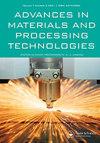燃气轮机用感应淬火IN718合金疲劳寿命研究的设计与优化
IF 2.1
Q3 MATERIALS SCIENCE, MULTIDISCIPLINARY
Advances in Materials and Processing Technologies
Pub Date : 2023-09-13
DOI:10.1080/2374068x.2023.2256121
引用次数: 1
摘要
因科耐尔718 (IN718)高温合金由于其优异的耐腐蚀性和高温性能,通常用作工业燃气轮机的部件。一般来说,燃气轮机在其使用中由于高热疲劳而出现故障。本研究将Inconel 718高温合金试样分别在850℃和1000℃(IHT1和IHT2)两种不同温度下进行油淬处理。在室温和800℃下,分别以0.6%、0.7%和0.8%的应变幅值控制试样的应变幅值。在室温和高温下,在上述应变幅值下,感应淬火试样的疲劳寿命大于未处理试样,而随着应变幅值的增加,所有试样的疲劳寿命都减小。有趣的是,随着疲劳试验的进行,三种应变幅值之间的应力差逐渐减小,与未经处理的试样相比,感应硬化试样具有循环软化行为。此外,通过扫描电镜(SEM)观察,本研究中IN718高温合金的断裂方式完全是穿晶断裂。本文章由计算机程序翻译,如有差异,请以英文原文为准。
Design and optimization of fatigue life studies on induction hardened IN718 alloy for gas turbine applications
The Inconel 718 (IN718) superalloy is commonly used as a component in industrial gas turbines due to its excellent corrosion resistance and high-temperature properties. Generally, gas turbines experience failure in their service on account of high thermal fatigue. In the present research, specimens of Inconel 718 superalloy are treated at two different temperatures 850℃ and 1000℃ (IHT1 & IHT2) with oil quenching, respectively. The specimens are studied with controlled strain amplitudes for different values 0.6%, 0.7% & 0.8% at room temperature and 800°C. It is noticed that the fatigue lifetimes of induction-hardened specimens are greater than those of untreated specimens at the above-mentioned strain amplitude values at room and elevated temperature, whereas the fatigue life of all the specimens reduces as strain amplitudes increase. Interestingly, the stress difference among the three strain amplitudes gradually decreases as the fatigue test progresses and induction-hardened specimens have cyclic softening behaviour as compared to untreated specimens’ cyclic hardening behaviour. Additionally, the mode of fracture for IN718 superalloys in the current study is entirely transgranular, as shown by the fracture surface observation using a scanning electron microscope (SEM).
求助全文
通过发布文献求助,成功后即可免费获取论文全文。
去求助
来源期刊

Advances in Materials and Processing Technologies
MATERIALS SCIENCE, MULTIDISCIPLINARY-
CiteScore
3.90
自引率
27.30%
发文量
222
 求助内容:
求助内容: 应助结果提醒方式:
应助结果提醒方式:


